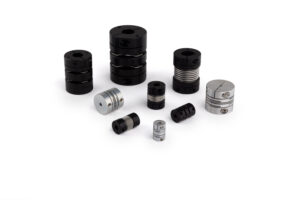By Chris Gumas, Director of Marketing, Ruland Manufacturing

Matching high-torque applications with the ideal servo coupling demands careful consideration of several factors, including torque and misalignment capabilities, speed requirements, and spatial constraints. Ruland offers a range of high-torque servo couplings – bellows, disc, and slit – each designed to address these factors in unique ways. This article provides a comprehensive comparison, shedding light on the critical attributes of each coupling type and guiding you toward the right fit for your application’s specific demands.
Bellows couplings have the highest torque and torsional stiffness capabilities in the Ruland flexible coupling offering at the expense of misalignment. They are comprised of two aluminum hubs, and a flexible center element called a bellows. The thin walls of the stainless-steel bellows flex while remaining rigid under torsional loads, giving bellows couplings high rigidity to transmit position accurately in the most demanding applications. Bellows couplings are designed for applications requiring precise rotation and dynamic motion, making them an ideal choice for the most demanding servo-driven applications.
Functionally, disc couplings are close to bellows couplings but have slightly more misalignment capabilities at the expense of torque and stiffness. They are available in single and double-disc styles. The single disc style is comprised of two aluminum hubs mated to stainless steel disc springs. It is a compact design with equivalent torque and higher stiffness than double disc styles. Designers must be careful when using a single disc coupling, as they have no accommodation for parallel misalignment. Since the torque values are the same, the primary benefit of using a single disc coupling is for space efficiency.

Double disc styles feature two aluminum hubs, a center spacer, and two sets of disc springs. This design allows the double disc coupling to function like a double cardan u-joint, with each hub operating independently. Additional disc springs reduce stiffness while maintaining consistent torque compared to the single-disc style. Double disc couplings can accommodate all forms of misalignment, making them the preferred disc coupling choice for designers.

(Source: Ruland)
Slit couplings are ideally suited for applications that require precise positioning and demand a balance of torque, stiffness, misalignment, and high-speed capabilities. This combination of performance characteristics makes them a suitable interchange for couplings such as single disc, which has misalignment and speed limitations. Slit couplings come in long and short styles. Short styles have higher stiffness, while long ones have increased misalignment capabilities. Speed is a primary differentiator with slit couplings compared to the other high-torque couplings. Bellows and disc couplings max at 10,000 rpm. Slit couplings, in comparable bore sizes, have speed capabilities up to 30,000 rpm.
The chart for torque comparison of similarly sized couplings helps select the right coupling type and style, giving an idea of how the couplings stack up against each other. There can be variations depending on the outer diameter size of the coupling:

When selecting a high-torque coupling, it is critical to understand all factors to make the right choice. Each coupling style brings its own set of strengths and weaknesses, tailored to meet specific high-torque challenges. Bellows couplings provide Ruland servo couplings’ best size-for-size torque capabilities with limited misalignment capabilities. Disc couplings have higher misalignment than bellows couplings with slightly reduced torque capabilities. Slit couplings have better misalignment and can fit in more confined spaces than a disc or bellows coupling. Choosing the proper coupling allows the system to maximize its performance.
Ruland
ruland.com

Leave a Reply